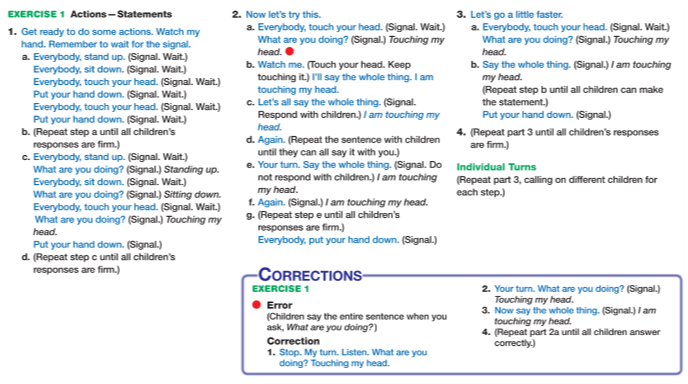Back to Course
Teach Language for Learning
0% Complete
0/0 Steps
-
Module introduction5 Topics
-
Overview21 Topics|4 Tests
-
Cover
-
Lesson objective
-
Opening the lesson
-
Features of Direct Instruction overview
-
Why language instruction?
-
Who it’s for and why it works
-
Why it works
-
LFL for playschool students
-
LFL Lesson 2, exercise 4
-
Language for Learning materials
-
Teacher’s Guide
-
How to set up a group
-
Teacher presentation books
-
LFL lesson 1 exercise 1 with error correction
-
Why signals?
-
Hand-drop signal
-
Hand-drop signal
-
Point-touch signal
-
Point-touch signal
-
Review
-
Lesson completed
-
Cover
-
Actions A17 Topics|4 Tests
-
Cover
-
Lesson objective
-
Opening the lesson
-
Why teach action exercises?
-
Video (VIDEO UNDER DEVELOPMENT)
-
Basic actions – beginning actions
-
Video (VIDEO UNDER DEVELOPMENT)
-
Correcting errors
-
Correcting errors: part 2
-
Video (VIDEO UNDER DEVELOPMENT)
-
Actions — statements
-
Video (VIDEO UNDER DEVELOPMENT)
-
Actions — parts of the body
-
General correction procedure
-
Video (VIDEO UNDER DEVELOPMENT)
-
Review
-
Lesson completed
-
Cover
-
Actions B20 Topics|3 Tests
-
Cover
-
Lesson objective
-
Opening the lesson
-
Kinds of action exercises
-
Actions — pictures
-
Video
-
Action statement — pictures
-
Video
-
Individual turns
-
Video
-
Steps of individual turns
-
Test your understanding
-
Action statement with ‘not’
-
Video
-
Action — pronouns
-
Action — tense demonstration
-
Action — tense — pictures
-
Video
-
Review
-
Lesson completed
-
Cover
-
Description of objects A20 Topics|3 Tests
-
Cover
-
Lesson objective
-
Opening the lesson
-
Why teach description of object exercises
-
Kinds of description of action exercises
-
Video
-
Object identification
-
Video
-
Identity statements
-
Video
-
Identity statements no model
-
Yes-or-no questions and ‘not’ statements
-
Video
-
General correction procedure
-
Yes-or-no questions/’not’ statements/no model
-
Video – WITH VIDEO
-
Common objects
-
Test your understanding
-
Review
-
Lesson completed
-
Cover
-
Description of objects B18 Topics|4 Tests
-
Information and background knowledge A19 Topics|4 Tests
-
Cover
-
Lesson objective
-
Opening the lesson
-
Why teach information and background knowledge
-
Basic information
-
Video
-
Basic information – school
-
Video
-
Days of the week
-
General correction procedure
-
Months of the year
-
Seasons
-
Video
-
Purpose of part/whole
-
Pause and punch
-
Part/whole
-
Video
-
Review
-
Lesson completed
-
Cover
-
Information and background knowledge B16 Topics|4 Tests
-
Instructional words and problem-solving concepts A24 Topics|4 Tests
-
Cover
-
Lesson objective
-
Opening the lesson
-
Purpose of instructional words and problem-solving concepts
-
Spatial and temporal Relations- First, next
-
Video 28 LFL Lesson 17, exercise 3
-
Video
-
First, next, last
-
General correction procedure
-
Purpose of teaching prepositions
-
Prepositions demonstration
-
Prepositions with pictures
-
Video 29 LFL lesson 31, exercise 5 with error correction
-
Video
-
And – actions
-
Same/different
-
Same
-
Video 30 LFL Lesson 96, exercise 6
-
Video
-
Actions different
-
Video 31 LFL lesson 113, exercise 1
-
Video
-
Review
-
Lesson completed
-
Cover
-
Instructional words and problem-solving concepts B18 Topics|4 Tests
-
Classification A12 Topics|4 Tests
-
Classification B12 Topics|4 Tests
-
Problem solving strategies and applications A11 Topics|4 Tests
-
Problem solving strategies and applications B14 Topics|4 Tests
-
Workbook23 Topics|4 Tests
-
Cover
-
Lesson objective
-
Opening the lesson
-
Purpose of workbook exercises
-
Content of workbook exercises
-
Presenting the workbook activities
-
Auditory signal
-
Touching, colours, cross-out marks
-
Video
-
Video
-
Correcting workbooks
-
Pair relations
-
First/next
-
Video
-
Video
-
Part/whole, shapes, opposites, plurals
-
Classification, concept applications
-
Prepositions, locations
-
Same/different, some/all/none, materials
-
Video
-
Video
-
Review
-
Lesson completed
-
Cover
-
Stories, poems, additional activities, expanded language activities17 Topics|4 Tests
-
Cover
-
Lesson objective
-
Opening the lesson
-
Why teach stories and poems?
-
Stories and poems in LFL
-
Presenting stories and poems
-
Video
-
Video
-
Purpose of expanded activities
-
Included activities
-
Parent letters
-
Language Activity masters
-
Language Centres for Young Learners
-
Video
-
Video
-
Review
-
Lesson completed
-
Cover
-
Mastery tests and data collection18 Topics|4 Tests
-
Cover
-
Lesson objective
-
Opening the lesson
-
Measurable student improvement
-
Mastery test materials
-
Conducting mastery tests
-
Video 50 Conducting mastery tests
-
Video
-
Scoring mastery tests
-
Video 51 scoring mastery tests
-
Video
-
Extra help
-
Attendance on Student Progress Tool (SPT)
-
Lesson progress on SPT
-
Record independent work on SPT
-
Mastery tests on SPT
-
Review
-
Lesson completed
-
Cover
-
Motivating students and positive feedback17 Topics|4 Tests
-
Cover
-
Lesson objective
-
Opening the lesson
-
Engaging students
-
Teacher’s role in motivation
-
Video 12 Language for Learning Lesson 1, exercise 4 with error correction
-
Video
-
STAR rules
-
STAR rules continued
-
Teacher-student game
-
Teacher-student game points
-
Video 52 Teacher-student game
-
Independent work
-
Positive praise
-
Specific praise
-
Review
-
Lesson completed
-
Cover
-
Practise time, lesson 4429 Topics|2 Tests
-
Cover
-
Lesson objective
-
Opening the lesson
-
Checklist for teaching a complete lesson
-
LFL lesson 44, exercise 1
-
Video
-
Video
-
LFL lesson 44, exercise 2
-
Video
-
Video
-
LFL lesson 44, exercise 3
-
Video
-
Video
-
LFL lesson 44, exercise 4
-
Video
-
Video
-
LFL lesson 44, exercise 5
-
Video
-
Video
-
LFL lesson 44, exercise 6
-
Video
-
Video
-
LFL lesson 44, exercise 7
-
Video
-
Video
-
LFL lesson 44 Workbook
-
Video
-
Review
-
Lesson completed
-
Cover
-
Module evaluation survey1 Topic
Participants 499
Lesson 3,
Topic 11
In Progress
Actions — statements
ddewell@goodtogreatschools.org.au August 8, 2023
Lesson Progress
0% Complete

Actions — statements
In this action exercise, students learn to ‘say the whole thing’. That means they make a statement about what they are doing. The exercise moves from easy to more difficult.
First, they do the actions with no verbal response.
Next, they label their action, ‘Touching my head’.
Finally, they make an action statement,
‘I am touching my head’.
The process is:
LFL Teacher’s Guide, page 30, lesson 7, exercise 1, steps 1, 2, 3.

In the next slide you will see a demonstration of lesson 7, exercise 1.
Turn to page 30 in LFL Teacher’s Guide and follow along with the teacher as she teaches exercise 1, 2 and 3.
See if you can answer these questions.

- What kind of signal is the teacher using?
- What word is stressed when the teacher says, ‘ What are you doing?’
- What words are stressed when the teacher says, ‘Say the whole thing’?
The process is:
- In part one, make sure students can do the actions.
- Make sure students do not respond with a complete statement, ‘I am touching my head’, when they are just supposed to label the action, ‘Touching my head’.
- In part two make sure students are doing the action as they talk about it. They should keep touching their heads as they make the statement, ‘I am touching my head’.
- The words and statements may not have meaning unless they are doing the action and talking about it.

